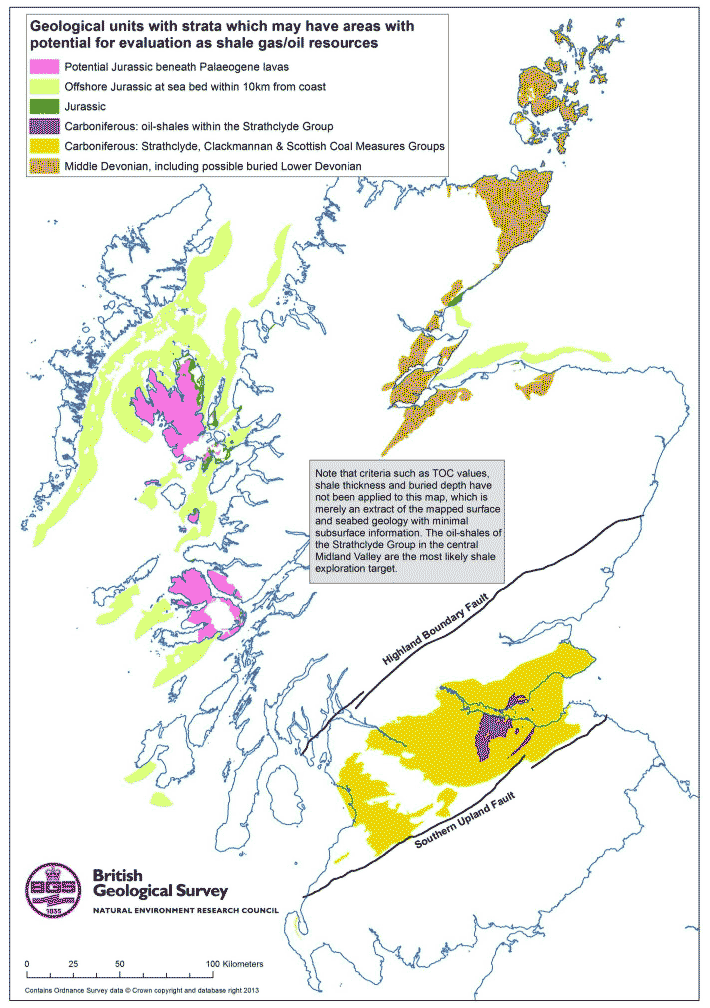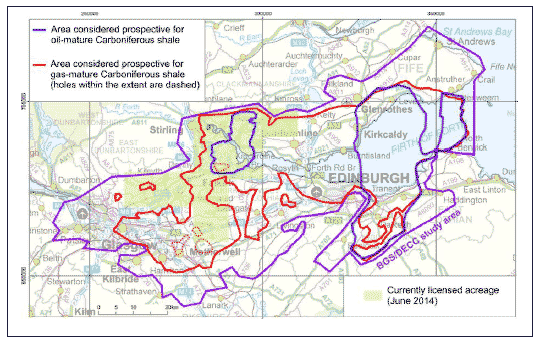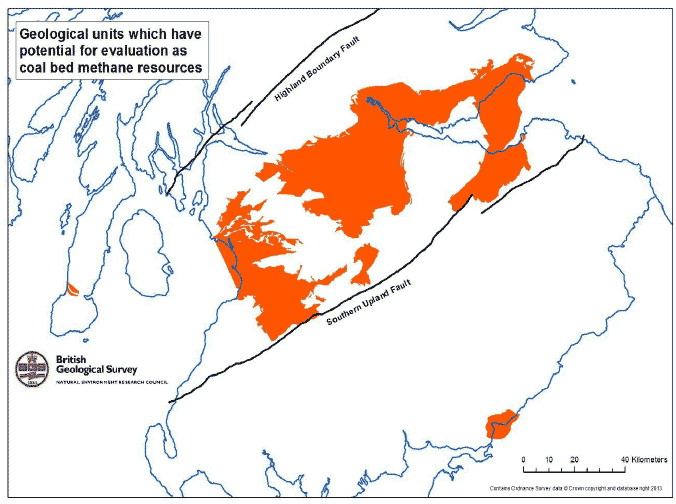Expert Scientific Panel on Unconventional Oil and Gas report
A report published on behalf of the Expert Scientific Panel on Unconventional Oil and Gas, which reviews the available scientific evidence.
Chapter 4 - The Potential in Scotland
Introduction
4.1 There are a number of areas within Scotland that have the potential to yield unconventional hydrocarbon resources. This chapter is an assessment of the most likely geological units in Scotland with potential to host unconventional oil and gas resources, and seeks to highlight the knowledge gaps. This section examines coalbed methane, shale oil and shale gas. Tight oil and tight gas in sandstones are not included in this review - these are locations where oil or gas are conventionally contained in porous sandstones, but are unlikely to have sufficient permeability for commercial production.
Source Rock - Shale
4.2 Shale is a fine-grained, laminated sedimentary rock that is formed by the compaction of silt and clay sized particles and organic debris. Black shales can be rich in organic carbon. On heating during burial in the Earth's crust, these organic-rich sediments can produce oil and gas. Shale oil is produced by burial to depths where temperatures of around 60 - 160ºC are reached (the oil generation window), and shale gas is generated at temperatures of around 150 - 200 ºC (the gas generation window) during deeper burial. These products can be retained in the shale, even if the rock is uplifted to cooler temperatures.
4.3 Unlike conventional oil and gas bearing high-permeability sandstones, shales are rocks of naturally low permeability. However, organic-rich shales can contain significant amounts of free gas or oil within microscopic pores and fractures, and also bound oil or gas adsorbed onto the surfaces of organic matter particles. Horizontal drilling and hydraulic fracturing (fracking) can create new fractures and enhance the natural fractures within the shale, and permit recovery of gas and oil. To ensure sufficient flow rates of gas or oil to flow to the surface, a depth for shale of 1,500 metres below the land surface has been established in USA shale gas (Charpentier and Cook, 2011), and is suggested in the UK (Andrews, 2013).
4.4 Some organic shales can also be distilled to produce oil and gas, and this was done in West Lothian in the 19 th and early 20 th Centuries (see section 3.21 above), with the last operation closing in 1962.
4.5 Total production from Scottish oil-shale was estimated to be around 75 million barrels, with an estimated 37 million barrels still remaining (Cameron and McAdam, 1978; Hallett et al, 1985).
Potential source rocks for shale oil and shale gas recovery in Scotland
4.6 Experience from North America indicates the main geological criteria identified for successful shale exploration ( DECC, 2010a) include:
- Shales containing more than 2% Total Organic Carbon ( TOC);
- Organic matter type (Type I and II kerogen preferred);
- Depths from surface to the shale ranging from about 1,000 to 3,500 metres;
- Maturity of shale must be limited to the oil and gas windows ( i.e. when the correct geological conditions exist for the thermal production of hydrocarbons) - this must have happened in the geological past, rather than under conditions present today;
- The presence of conventional oil and gas fields;
- The presence of oil or gas shows (leaks) from shales.
4.7 North American experience also indicates that shale gas well productivity is highly variable; gas from wells in 'sweet spots' can far exceed the average recovery from wells across an area. 'Sweet spots' tend to be areas where organic content, porosity and permeability are high, clay content is low, thermal history is favourable and the shale is highly 'frackable' (brittle with a high density of interconnected natural fractures).
4.8 For Scotland, there are very limited published data available to enable assessment of most of these criteria. There are few boreholes deeper than 1 km, and minimal modern seismic reflection surveys. Further research and exploratory deep drilling and production will be required before reserves can be estimated. The BGS has recently published a detailed study, which was commissioned by DECC, of the shale gas (but not CBM) and shale oil in place resource based on available data for the Central Belt of Scotland (Monaghan, 2014).
Shale occurrences in Scotland
4.9 Potential shale resources occur onshore or near-shore in three main geological settings in Scotland ( Figure 4.1):
- Carboniferous rocks of the Midland Valley;
- Devonian rocks of Caithness, Orkney, and the Moray Firth coast;
- Jurassic rocks of the Inner Hebrides, Moray Firth and offshore basins close to the coast.
4.10 The lowest risk targets are likely to be those where shale is associated with conventional hydrocarbon discoveries, such as the Carboniferous shales of the Midland Valley.
4.11 The most likely geological settings which may have areas with potential shale gas or shale oil resources at depth are described in more detail below, in order of increasing exploration risk.
Carboniferous of the Midland Valley
4.12 Carboniferous rocks of the Midland Valley are the most likely targets for shale gas and shale oil exploration. The West Lothian Oil Shale Formation is likely to have the greatest potential as minor oil and gas discoveries have been made (Hallett et al, 1985; Underhill et al, 2008; Bide et al, 2008; Smith et al, 2008a, b, c).
4.13 At surface, the West Lothian Oil Shale Formation has not been heated sufficiently to produce oil or gas, but studies of outcropping rocks show that it is an excellent source rock for oil and gas with a Total Organic Carbon ( TOC) content of up to 30% (Parnell, 1988). In comparison, US shales are as little as 2 - 3% TOC.
Figure 4.1. Map of geological units containing strata which may have areas with potential for evaluation as shale gas/oil resources. Note that criteria such as TOC values, shale thickness and buried depth have not been applied to this map, which is merely an extract of the mapped surface and seabed geology with minimal subsurface information. The oil-shales of the Strathclyde Group in the central Midland Valley are the most likely shale exploration target. The Shetland Islands are not included as the area is considered to be un-prospective for shale gas or oil (see section 4.17).

4.14 Up to thirteen organic-rich oil-shale seams with a combined thickness of around 35 m occur within the West Lothian Oil Shale Formation, which was originally deposited in a large stratified algal-rich freshwater lake or lagoon, termed 'Lake Cadell' (Cameron and McAdam, 1978; Read et al, 2002). The formation reaches a maximum thickness of 1,120m in the centre of the West Lothian basin around West Calder, but thins to the north, north-west and south (Browne et al, 1999).
4.15 Little is known about the extent of the Oil Shale Formation to the west of the outcrop, but if present, it is likely to be at considerable depth. Information from the BP Salsburgh 1A well, east of Airdrie, suggests that the West Lothian Oil Formation may be present in this area (Cameron and McAdam, 1978). This well produced 9,345 m 3 per day (330,000 cubic feet per day) gas at about 850 m downhole on testing. Unfortunately the well was not logged to total depth so the identification of oil-shales in the well was derived only from drill cuttings (Department of Energy and Climate Change, DECC 2010b).
4.16 Other potential targets in Midland Valley Carboniferous strata include the organic-rich mudstones of the Gullane, Lower Limestone and the Limestone Coal formations. The Scottish Coal Measure Group rocks are unlikely to be buried to sufficient depth to be prospective for shale gas, but may be prospective for shale oil.
4.17 The DECC-commissioned report by the BGS provides 3D models and resource estimates for in place shale gas and shale oil ( Table 4.1) and the distribution of areas considered prospective for shale gas or shale oil are summarised in Figure 4.2.
Figure 4.2 Areas of the Central Belt considered prospective for shale gas and shale oil (Monaghan, 2014)

Table 4.1 Estimates of the potential total in-place shale oil and shale gas resource in the Carboniferous Midland Valley study area (Monaghan, 2014)
| Total gas in-place estimates (tcm) |
Total gas in-place estimates (tcf) |
|||||
|---|---|---|---|---|---|---|
| Low (P90) |
Central (P50) |
High (P10) |
Low (P90) |
Central (P50) |
High (P10) |
|
| Shale gas | 1.40 | 2.27 | 3.81 | 49.4 | 80.3 | 134.6 |
| Total oil in-place estimates (million tonnes) |
Total oil in-place estimates (billion barrels) |
|||||
| Low (P90) |
Central (P50) |
High (P10) |
Low (P90) |
Central (P50) |
High (P10) |
|
| Shale oil | 421 | 793 | 1,497 | 3.2 | 6.0 | 11.2 |
Devonian of the Caithness, Orkney, and the Moray Firth coast
4.18 Shales are widespread within the Lower and Middle Devonian Old Red Sandstone rocks of the Orcadian Basin in Caithness, Orkney, Shetland Islands and the Moray Firth coast:
- Lower Devonian strata - The entire Devonian sequence exceeds 4,000 m in thickness towards the centre of the Orcadian Basin. If the geology identified offshore is extrapolated onshore, this may locally include significant thicknesses of Lower Devonian lacustrine shales, with possible shale gas potential ( DECC, 2010a);
- Middle Devonian strata - The Caithness Flagstone Group of Orkney and Caithness and the overlying Eday Group of Orkney both contain organic-rich shales. Their potential for oil and gas was first investigated by Murchison (1859), and Parnell (1983) documented occurrences of hydrocarbons. More recently, these rocks have been intensively studied as geochemical data indicate they were a contributory source rock for the Beatrice oilfield in the Moray Firth (Bailey et al, 1990). The Lower Stromness Flagstone Formation has TOC values over 6%, whereas the Upper Stromness Flagstone Formation have an average TOC of 2.3%. These organic-rich lacustrine shales are about 160 m thick in total, but dispersed in units around 1.5 m thick within a total rock thickness of around 800 m ( DECC, 2010a);
- Middle Devonian source rocks of the Orcadian basin are mostly still within the oil window today (Marshall et al, 1985) and are, therefore, unlikely to be productive for shale gas. However, they may have potential for shale oil. Shales within the Middle Devonian of Shetland have all been heated beyond 500 ºC (Marshall et al, 1985), where most of the transformations from organic to gas have been completed, and hence are un-prospective for shale gas or oil.
Jurassic of Inner Hebrides, Moray Firth, and offshore Basins
4.19 Jurassic rocks, including shales, occur on the west coast from Mull to Skye and along the Moray Firth coasts. The most extensive outcrops occur on Skye and Raasay in the west and from Golspie to Helmsdale. A single 4 - 6 metre thick organic-rich shale within the Cullaidh Shale Formation at Elgol in Skye has a TOC of 5%, and black shale within the Brora Coal Formation at Brora has a TOC of 20% (Hudson and Trewin, 2002).
4.20 On Skye, Eigg and Mull, Jurassic rocks are overlain by volcanic rocks of Palaeogene age (Emeleus and Bell, 2005; Hesselbo et al, 1998). The extent of the Jurassic rocks below the underlying volcanics is not known, but may represent a potential shale gas/oil exploration target.
4.21 Extensive areas of Jurassic rock are developed under the sea in the Inner Hebrides, Sea of the Hebrides, West Shetland and Moray Firth basins. These may be potential shale gas/oil exploration targets, particularly if developed from land.
Coal Bed Methane ( CBM) Resources
4.22 Coal is a sedimentary rock composed mainly of carbon derived largely from plant material deposited in ancient tropical forests. CBM is a gas found naturally within coal seams. Typically it consists of 80 - 95% methane, the remainder being other hydrocarbons, nitrogen and carbon dioxide, together with traces of argon, helium and hydrogen (Creedy, 1991).
4.23 An assessment of new coal exploitation technologies in the UK was carried out by BGS for the former Department of Trade and Industry (Jones et al, 2004). It was estimated that the total CBM resource in the UK is 2.9 trillion m 3 (102 tcf), and that the recoverable part of the resource is unlikely to exceed 1% of this resource due to low seam permeability, low gas content and planning constraints. No separate figure is available for Scotland. From areal estimates of resources ( DECC, 2010), it is possible that Scottish resources are just 22% of those of the whole UK.
4.24 However, DECC (2010) report that USA CBM developments have now been proven to achieve recovery of 30-40% in some fields and suggest that if 10% of the UK CBM resource potential could be developed, this would be equivalent to over three years of UK natural gas supply. This has not yet been tested by extensive UK drilling or production.
4.25 Development of commercial CBM would be required before a more reliable reserve estimate can be made as this would provide data on important factors such as: coal permeability, gas content, gas saturation from cores, well density, permit costs, environmental studies and mitigation costs, production profiles, and costs of drilling ( DECC, 2010).
4.26 Potential CBM resources in Scotland are likely to be found in the Midland Valley, within the Limestone Coal Formation of the Clackmannan Group and the younger Scottish Coal Measures Group. Other resources may be present with the Coal Measures Group in the Canonbie area, east of Dumfries ( Figure 4.3).
4.27 Jones et al (2004) regard the Limestone Coal Formation as the main CBM target in Scotland and the Clackmannan Coalfield as probably the most prospective of the Midland Valley coalfields.
4.28 Seam methane contents of 8 - 10 m 3/tonne have been reported from ten seams 850 - 900 metres deep within the Limestone Coal Formation at Airth, south-east of Stirling, where significant gas and water production has been established from Dart Energy (formerly Composite Energy) CBM wells (Bacon, 1995). No public domain information on the gas content, permeability or water and gas production of the Airth wells is currently available ( DECC, 2010).
Figure 4.3. Areas of the Midland Valley of Scotland with the surface, proven and possible subsurface occurrences of the Clackmannan and Scottish Coal Measures Groups which have potential for evaluation as coal bed methane resources. More detailed information on areas likely to have the highest potential for CBM is available on the detailed maps produced by Jones et al. (2004).

Conclusions
4.29 The most likely geological settings that may have areas with potential shale gas or shale oil resources at depth, in order of increasing exploration risk, are:
- Carboniferous Strathclyde Group of the Midland Valley, specifically the West Lothian Oil Shale Formation;
- Lower and Middle Devonian rocks of Caithness, Orkney and the Moray Firth coastal areas;
- Jurassic rocks along and the west coast from Mull to Skye and east Sutherland, and offshore Jurassic rocks close to the shore.
4.30 Proven CBM resources have been found within the Limestone Coal Formation at Airth, south-east of Stirling, and this formation is regarded as the main CBM target in the Midland Valley. The Clackmannan Coalfield is probably the most prospective of the Midland Valley coalfields for CBM resources. Other resources may be present with the Coal Measures Group in the Canonbie area, east of Dumfries.
Contact
There is a problem
Thanks for your feedback